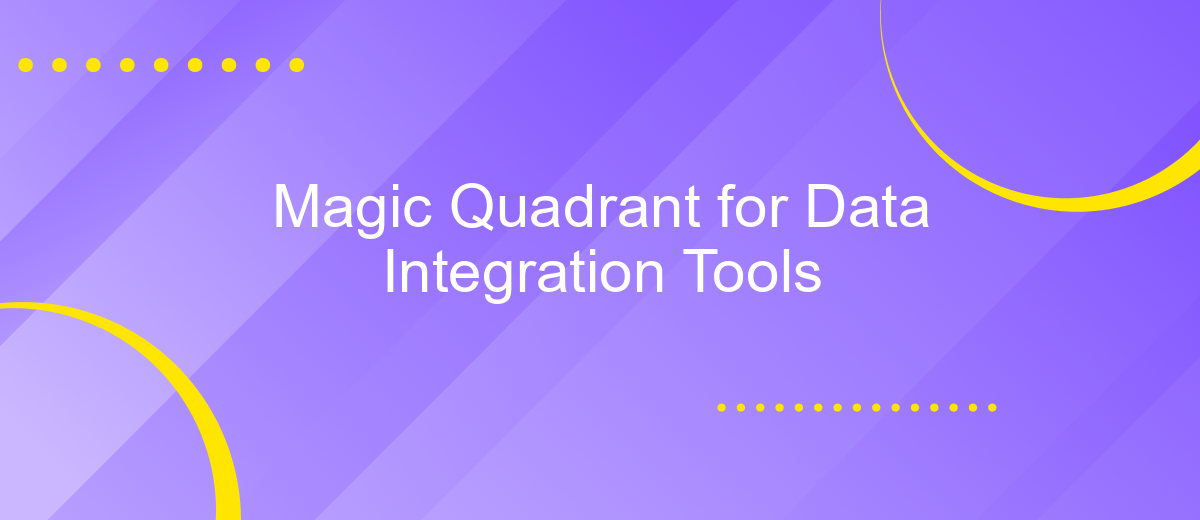Magic Quadrant for Data Integration Tools
The Magic Quadrant for Data Integration Tools provides a comprehensive analysis of the top vendors in the data integration market. This report evaluates their strengths, weaknesses, and overall market positions, helping businesses make informed decisions. Whether you're looking to streamline data processes or enhance analytics capabilities, understanding these tools is crucial for maintaining a competitive edge in today's data-driven world.
Market Definition and Dynamics
The data integration tools market is evolving rapidly, driven by the increasing need for businesses to manage and utilize vast amounts of data from diverse sources. Organizations are seeking efficient solutions to integrate data seamlessly, ensuring accuracy and accessibility across various platforms.
- Cloud-based data integration
- Real-time data processing
- API-driven integrations
- Scalability and flexibility
- Enhanced data security
One notable player in this market is ApiX-Drive, which offers a robust platform for setting up integrations quickly and efficiently. Its user-friendly interface and extensive library of connectors simplify the process of linking various applications and services. As the demand for agile and scalable data integration solutions grows, tools like ApiX-Drive are becoming essential for businesses aiming to stay competitive in a data-driven landscape.
Vendor Analysis

In the ever-evolving landscape of data integration tools, various vendors offer unique features and capabilities to meet diverse business needs. Leading the charge are established giants like Informatica, Talend, and Microsoft, each providing robust platforms that cater to large-scale data operations. Informatica excels in comprehensive data management solutions, while Talend focuses on open-source flexibility, and Microsoft leverages its Azure ecosystem for seamless cloud integrations. These vendors are known for their scalability, security, and extensive support networks, making them reliable choices for enterprises.
Emerging players like ApiX-Drive are also making significant strides in the market. ApiX-Drive offers a user-friendly interface and pre-built connectors, enabling quick and efficient data integrations without the need for extensive coding. This service is particularly beneficial for small to medium-sized businesses looking to automate workflows and enhance productivity with minimal technical overhead. By simplifying the integration process, ApiX-Drive allows organizations to focus on analyzing and utilizing data rather than getting bogged down in complex setup procedures.
Evaluation and Selection Guidance

When evaluating and selecting a data integration tool, it is essential to consider several key factors to ensure the solution aligns with your organizational needs and goals. Begin by assessing the specific data integration requirements of your business, such as the volume of data, types of data sources, and the complexity of data transformations needed.
- Identify the scalability and performance capabilities of the tool.
- Evaluate the ease of use and user interface, ensuring it is intuitive for your team.
- Check for compatibility with existing systems and data formats.
- Consider the level of support and documentation provided by the vendor.
- Review the cost structure and ensure it fits within your budget.
- Look for additional features such as real-time data processing and integration with cloud services.
Tools like ApiX-Drive can simplify the integration process by offering a user-friendly platform that supports a wide range of data sources and destinations. Its ability to automate workflows and synchronize data in real-time can significantly enhance your data management strategy. By carefully evaluating these aspects, you can select a data integration tool that effectively meets your business needs.
Key Findings and Recommendations

The Magic Quadrant for Data Integration Tools reveals significant advancements in the field, highlighting the growing importance of seamless data integration for businesses. As organizations increasingly rely on diverse data sources, the demand for robust integration solutions continues to rise.
Key findings indicate that leading data integration tools are focusing on enhancing scalability, ease of use, and real-time processing capabilities. Additionally, the integration of AI and machine learning is becoming a critical differentiator among top vendors.
- Prioritize tools that offer comprehensive support for various data sources and formats.
- Evaluate the scalability and performance of the integration solutions to ensure they meet future growth needs.
- Consider platforms like ApiX-Drive that simplify the integration process with user-friendly interfaces and extensive automation features.
- Look for vendors that incorporate advanced analytics and AI to enhance data processing and insights.
Organizations should invest in data integration tools that not only meet current requirements but also adapt to evolving data landscapes. The right tool will enable seamless data flow, improve decision-making, and drive operational efficiency.
Appendix
The Magic Quadrant for Data Integration Tools provides a comprehensive analysis of the leading solutions in the market, assessing their capabilities, strengths, and weaknesses. It serves as a valuable resource for organizations seeking to streamline their data integration processes, enabling them to make informed decisions on the most suitable tools for their unique needs. By evaluating vendors based on criteria such as functionality, ease of use, and customer support, the Magic Quadrant helps businesses navigate the complex landscape of data integration solutions.
One of the noteworthy tools in this space is ApiX-Drive, a versatile service designed to facilitate seamless data integration across various platforms. ApiX-Drive offers a user-friendly interface and robust features that simplify the process of connecting disparate systems, ensuring data flows smoothly and efficiently. With its ability to automate workflows and support a wide range of applications, ApiX-Drive stands out as a practical choice for organizations aiming to enhance their data integration capabilities. Its flexibility and reliability make it a valuable addition to any data integration strategy.
FAQ
What is the Magic Quadrant for Data Integration Tools?
How often is the Magic Quadrant for Data Integration Tools updated?
What criteria does Gartner use to evaluate data integration tools?
How can businesses use the Magic Quadrant for Data Integration Tools to make decisions?
Are there services that can help implement and automate data integration processes?
Routine tasks take a lot of time from employees? Do they burn out, do not have enough working day for the main duties and important things? Do you understand that the only way out of this situation in modern realities is automation? Try Apix-Drive for free and make sure that the online connector in 5 minutes of setting up integration will remove a significant part of the routine from your life and free up time for you and your employees.

